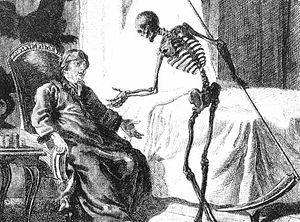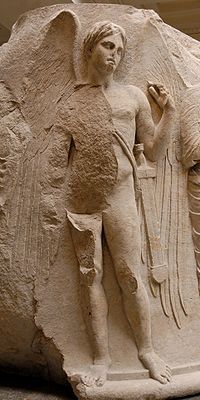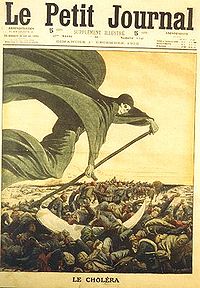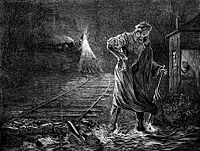- Death (personification)
-
"Grim Reaper" redirects here. For other uses, see Grim Reaper (disambiguation).
The concept of death as a sentient entity has existed in many societies since the beginning of history. In English, Death is often given the name Grim Reaper and, from the 15th century onwards, came to be shown as a skeletal figure carrying a large scythe and clothed in a black cloak with a hood. It is also given the name of the Angel of Death or Devil of Death or the angel of dark and light (Malach HaMavet) stemming from the Bible. The Bible itself does not refer to "The Angel of Death;" there is, however, a reference to "Abaddon" (The Destroyer), an Angel whose true identity is a mystery, as is the identity of "The Angel of the Abyss".
In some cases, the Grim Reaper is able to actually cause the victim's death,[1] leading to tales that he can be bribed, tricked, or outwitted in order to retain one's life, such as in the case of Sisyphus. Other beliefs hold that the Spectre of Death is only a psychopomp, serving to sever the last ties between the soul and the body and to guide the deceased to the next world without having any control over the fact of the victim's death. In many languages (including English), Death is personified in male form, while in others, it is perceived as a female character (for instance, in Slavic and Romance languages).
Contents
Indo-European folklore / mythology
Hellenic
Ancient Greece found Death to be inevitable, and, therefore, he is not represented as purely evil. He is often portrayed as a bearded and winged man, but has also been portrayed as a young boy. Death, or Thanatos, is the counterpart of life, death being represented as male, and life as female. He is the twin brother of Hypnos, the god of sleep. He is typically shown with his brother and is represented as being just and gentle. His job is to escort the deceased to the underworld, Hades. He then hands the dead over to Charon, who mans the boat that carries them over the river Acheron, which separates the land of the living from the land of the dead. It was believed that if the ferryman did not receive some sort of payment, the soul would not be delivered to the underworld and would be left by the riverside for a hundred years. Thanatos' sisters, the Keres, were the spirits of violent death. They were associated with deaths from battle, disease, accident, and murder. They were portrayed as evil, often feeding on the blood of the body after the soul had been escorted to Hades. They had fangs and talons, and would be dressed in bloody garments.
Celtic
Breton folklore shows us a spectral figure portending death, the Ankou. Usually the Ankou is the spirit of the last person that died within the community and appears as a tall, haggard figure with a wide hat and long white hair or a skeleton with a revolving head who sees everybody everywhere. The Ankou drives a deathly wagon or cart with a creaking axle. The cart or wagon is piled high with corpses and a stop at a cabin means instant death for those inside.
Poland
In Poland, Death, or Śmierć, has an appearance similar to the traditional Grim Reaper, but instead of a black robe, Death has a white robe.
Nordic
In Norway, Death is an old woman known by the name of Pesta, meaning "plague hag". She could fly, and wore a black hood. She would go into a town carrying either a rake or a broom. If she brought the rake, some people would survive the plague, if she brought the broom however, everyone would die.
Baltic
Lithuanians named Death Giltinė, deriving from word gelti ("to sting"). Giltinė was viewed as an old, ugly woman with a long blue nose and a deadly poisonous tongue. The legend tells that Giltinė was young, pretty and communicative until she was trapped in a coffin for seven years. The goddess of death was a sister of the goddess of life and destiny, Laima, symbolizing the relationship between beginning and end.
Later, Lithuanians adopted the classic Grim Reaper with a scythe and black robe.
Hindu Scriptures
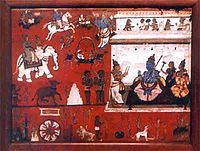 Yama-bunta, the Hindu lord of death, presiding over his court in hell
Yama-bunta, the Hindu lord of death, presiding over his court in hell
In Hindu scriptures, the lord of death is called Yama, or Yamaraj (literally "the lord of death"). Yamaraj rides a black buffalo and carries a rope lasso to carry the soul back to his abode, called "Yamalok"(the world of Yama - or the Underworld of the dead). There are many forms of reapers, although some say there is only one who disguises himself as a small child. His agents, the Yamaduts, carry souls back to Yamalok. There, all the accounts of a person's good and bad deeds are stored and maintained by Chitragupta. The balance of these deeds allows Yamaraj to decide where the soul has to reside in its next life, following the theory of reincarnation. Yama is also mentioned in the Mahabharata as a great philosopher and devotee of Supreme Brahman.
Yama is also known as Dharmaraj, or king of Dharma or justice. One interpretation is that justice is served equally to all whether they are alive or dead, based on their karma or fate. This is further strengthened by the idea that Yudhishtra, the eldest of the pandavas and considered as the personification of justice, was born due to Kunti's prayers to Yamaraj.
Buddhist scriptures also mention Yama or Yamaraj, much in the similar way.
East Asian folklore / mythology
In Chinese mythology, Yanluo (simplified Chinese: 阎罗; traditional Chinese: 閻羅; pinyin: Yánluó; Wade–Giles: Yen-lo), is the god of death and the ruler of Di Yu (Jp. 地獄 Jigoku, ko. 지옥 Jiok, "hell" or the underworld). The deity originated from Yama in Hinduism and was adopted into the Chinese pantheon and eventually spread to Japan as Enma-O (閻魔大王) and Korea as Great King Yŏmna (염라대왕). He is normally depicted wearing a Chinese judge's cap and traditional Chinese robes in both Chinese and Japanese depictions.
In Japanese mythology and in the Kojiki, after giving birth to the fire god Hinokagutsuchi, the goddess Izanami dies from wounds from his fire and enters the perpetual night realm called Yomi-no-kuni (the underworld) that the gods retire to and to which Izanagi, her husband, traveled in a failed attempt to reclaim her. He discovers his wife as not-so beautiful anymore, and, following a brief argument afterwards, she promises him she will take a thousand lives every day, signifying her position as the goddess of death.
There are also death gods called shinigami, which are closer to the Western tradition of the Grim Reaper. Shinigami (often plural) are common in modern Japanese arts and fiction and essentially absent from traditional mythology.
In Abrahamic religions
See also: Destroying angel (Bible)The "Angel of the Lord" smites 185,000 men in the Assyrian camp (II Kings 19:35). When the Angel of Death passes through to smite the Egyptian first-born, God prevents "the destroyer" (shâchath) from entering houses with blood on the lintel and side posts (Exodus 12:23). The "destroying angel" (mal'ak ha-mashḥit) rages among the people in Jerusalem (II Sam. 24:16). In I Chronicles 21:15 the "angel of the Lord" is seen by King David standing "between the earth and the heaven, having a drawn sword in his hand stretched out over Jerusalem." The biblical Book of Job (33:22) uses the general term "destroyer" (memitim), which tradition has identified with "destroying angels" (mal'ake Khabbalah), and Prov. 16:14 uses the term the "angels of death" (mal'ake ha-mavet). Azra'il is sometimes referred as the Angel of Death as well.[citation needed]
Memitim
 La mort du fossoyeur (Death of the gravedigger) by Carlos Schwabe
La mort du fossoyeur (Death of the gravedigger) by Carlos Schwabe
The memitim are a type of angel from biblical lore associated with the mediation over the lives of the dying. The name is derived from the Hebrew word mĕmītǐm and refers to angels that brought about the destruction of those whom the guardian angels no longer protected.[2] While there may be some debate among religious scholars regarding the exact nature of the memitim, it is generally accepted that, as described in the Book of Job 33:22, they are killers of some sort.[3]
In Judaism
Form and functions
According to the Midrash, the Angel of Death was created by God on the first day.[4] His dwelling is in heaven, whence he reaches earth in eight flights, whereas Pestilence reaches it in one.[5] He has twelve wings.[6] "Over all people have I surrendered thee the power," said God to the Angel of Death, "only not over this one which has received freedom from death through the Law."[7] It is said of the Angel of Death that he is full of eyes. In the hour of death, he stands at the head of the departing one with a drawn sword, to which clings a drop of gall. As soon as the dying man sees Death, he is seized with a convulsion and opens his mouth, whereupon Death throws the drop into it. This drop causes his death; he turns putrid, and his face becomes yellow.[8] The expression "to taste of death" originated in the idea that death was caused by a drop of gall.[9]
The soul escapes through the mouth, or, as is stated in another place, through the throat; therefore, the Angel of Death stands at the head of the patient (Adolf Jellinek, l.c. ii. 94, Midr. Teh. to Ps. xi.). When the soul forsakes the body, its voice goes from one end of the world to the other, but is not heard (Gen. R. vi. 7; Ex. R. v. 9; Pirḳe R. El. xxxiv.). The drawn sword of the Angel of Death, mentioned by the Chronicler (I. Chron. 21:15; comp. Job 15:22; Enoch 62:11), indicates that the Angel of Death was figured as a warrior who kills off the children of men. "Man, on the day of his death, falls down before the Angel of Death like a beast before the slaughterer" (Grünhut, "Liḳḳuṭim", v. 102a). R. Samuel's father (c. 200) said: "The Angel of Death said to me, 'Only for the sake of the honor of mankind do I not tear off their necks as is done to slaughtered beasts'" ('Ab. Zarah 20b). In later representations, the knife sometimes replaces the sword, and reference is also made to the cord of the Angel of Death, which indicates death by throttling. Moses says to God: "I fear the cord of the Angel of Death" (Grünhut, l.c. v. 103a et seq.). Of the four Jewish methods of execution, three are named in connection with the Angel of Death: Burning (by pouring hot lead down the victim's throat), slaughtering (by beheading), and throttling. The Angel of Death administers the particular punishment that God has ordained for the commission of sin.
A peculiar mantle ("idra"-according to Levy, "Neuhebr. Wörterb." i. 32, a sword) belongs to the equipment of the Angel of Death (Eccl. R. iv. 7). The Angel of Death takes on the particular form which will best serve his purpose; e.g., he appears to a scholar in the form of a beggar imploring pity (The beggar should receive Tzedakah.)(M. Ḳ. 28a). "When pestilence rages in the town, walk not in the middle of the street, because the Angel of Death [i.e., pestilence] strides there; if peace reigns in the town, walk not on the edges of the road. When pestilence rages in the town, go not alone to the synagogue, because there the Angel of Death stores his tools. If the dogs howl, the Angel of Death has entered the city; if they make sport, the prophet Elijah has come" (B. Ḳ. 60b). The "destroyer" (saṭan ha-mashḥit) in the daily prayer is the Angel of Death (Ber. 16b). Midr. Ma'ase Torah (compare Jellinek, "B. H." ii. 98) says: "There are six Angels of Death: Gabriel over kings; Ḳapẓiel over youths; Mashbir over animals; Mashḥit over children; Af and Ḥemah over man and beast."
Death and Satan
The Angel of Death, who is identified by some with Satan, immediately after his creation had a dispute with God as to the light of the Messiah (Pesiḳ. R. 161b). When Eve touched the tree of the knowledge of good and evil, she perceived the Angel of Death, and thought, "Now I shall die, and God will create another wife for Adam."[10] Adam also had a conversation with the Angel of Death (Böklen, "Die Verwandtschaft der Jüdisch-Christlichen mit der Parsischen Eschatologie", p. 12). The Angel of Death sits before the face of the dead (Jellinek, l.c. ii. 94). While Abraham was mourning for Sarah, the angel appeared to him, which explains why "Abraham stood up from before his death".[11] Samael told Sarah that Abraham had sacrificed Isaac in spite of his wailing, and Sarah died of horror and grief.[12] It was Moses who most often had dealings with the angel. At the rebellion of Korah, Moses saw him (Num. R. v. 7; Bacher, l.c. iii. 333; compare Sanh. 82a). It was the Angel of Death in the form of Pestilence who snatched away 15,000 every year during the wandering in the wilderness (ib. 70). When Moses reached heaven, the angel told him something (Jellinek, l.c. i. 61).
When the Angel of Death came to Moses and said, "Give me thy soul," Moses called to him: "Where I sit thou hast no right to stand." The Angel retired ashamed and reported the occurrence to God. Again, God commanded him to bring the soul of Moses. The Angel went and, not finding him, inquired of the sea, of the mountains, and of the valleys; but they knew nothing of him.[13] Really, Moses did not die through the Angel of Death, but through God's kiss (bi-neshiḳah); i.e., God drew his soul out of his body (B. B. 17a; compare Abraham in Apocryphal and Rabbinical Literature, and parallel references in Böklen, l.c. p. 11). Legend seizes upon the story of Moses' struggle with the Angel of Death and expands it at length (Tan., ed. Stettin, pp. 624 et seq.; Deut. R. ix., xi.; Grünhut, l.c. v. 102b, 169a). As Benaiah bound Ashmedai (Jew. Encyc. ii. 218a), so Moses binds the Angel of Death that he may bless Israel.[14]
Solomon once noticed that the Angel of Death was grieved. When questioned as to the cause of his sorrow, he answered: "I am requested to take your two beautiful scribes." Solomon at once charged the demons to convey his scribes to Luz, where the Angel of Death could not enter. When they were near the city, however, they both died. The Angel laughed on the next day, whereupon Solomon asked the cause of his mirth. "Because," answered the Angel, "thou didst send the youths thither, whence I was ordered to fetch them" (Suk. 53a). In the next world, God will let the Angel of Death fight against Pharaoh, Sisera, and Sennacherib.[15]
Scholars and the Angel of Death
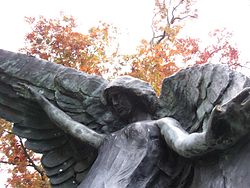 Black Angel, Oakland Cemetery (Iowa City, Iowa)
Black Angel, Oakland Cemetery (Iowa City, Iowa)
Talmud teachers of the fourth century associate quite familiarly with him. When he appeared to one on the street, the teacher reproached him with rushing upon him as upon a beast, whereupon the angel called upon him at his house. To another, he granted a respite of thirty days, that he might put his knowledge in order before entering the next world. To a third, he had no access, because he could not interrupt the study of the Talmud. To a fourth, he showed a rod of fire, whereby he is recognized as the Angel of Death (M. K. 28a). He often entered the house of Bibi and conversed with him (Ḥag. 4b). Often, he resorts to strategy in order to interrupt and seize his victim (B. M. 86a; Mak. 10a).
The death of Joshua ben Levi in particular is surrounded with a web of fable. When the time came for him to die and the Angel of Death appeared to him, he demanded to be shown his place in paradise. When the angel had consented to this, he demanded the angel's knife, that the angel might not frighten him by the way. This request also was granted him, and Joshua sprang with the knife over the wall of paradise; the angel, who is not allowed to enter paradise, caught hold of the end of his garment. Joshua swore that he would not come out, and God declared that he should not leave paradise unless he was absolved from his oath; if not absolved, he was to remain. The Angel of Death then demanded back his knife, but Joshua refused. At this point, a heavenly voice (bat ḳol) rang out: "Give him back the knife, because the children of men have need of it" (Ket. 77b; Jellinek, l.c. ii. 48-51; Bacher, l.c. i. 192 et seq.).
Rabbinic views
The Rabbis found the Angel of Death mentioned in Psalm 134:45 it should be noted that Psalms 134 only has 3 verses in all English translations)(A. V. 48), where the Targum translates: "There is no man who lives and, seeing the Angel of Death, can deliver his soul from his hand." Eccl. 8:4 is thus explained in Midrash Rabbah to the passage: "One may not escape the Angel of Death, nor say to him, 'Wait until I put my affairs in order,' or 'There is my son, my slave: take him in my stead.'" Where the Angel of Death appears, there is no remedy (Talmud, Ned. 49a; Hul. 7b). If one who has sinned has confessed his fault, the Angel of Death may not touch him (Midrash Tanhuma, ed. Buber, 139). God protects from the Angel of Death (Midrash Genesis Rabbah lxviii.).
By acts of benevolence, the anger of the Angel of Death is overcome; when one fails to perform such acts the Angel of Death will make his appearance (Derek Ereẓ Zuṭa, viii.). The Angel of Death receives his order from God (Ber. 62b). As soon as he has received permission to destroy, however, he makes no distinction between good and bad (B. Ḳ. 60a). In the city of Luz. the Angel of Death has no power, and, when the aged inhabitants are ready to die, they go outside the city (Soṭah 46b; compare Sanh. 97a). A legend to the same effect existed in Ireland in the Middle Ages (Jew. Quart. Rev. vi. 336).
In Christianity
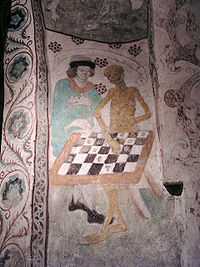 Medieval painting of Death playing chess from Täby Church in Sweden
Medieval painting of Death playing chess from Täby Church in Sweden
Death is, either as a metaphor, a personification or an actual being, referenced occasionally in the New Testament, although it can be debated whether these texts are discussing death as a being or as a concept. If the former, one such personification is found in Acts 2:24 – "But God raised Him [Jesus] from the dead, freeing Him from the agony of death, because it was impossible for Death to keep its hold on Him." Later passages, however, are much more explicit. Romans 5 speaks of Death as having "reigned from the time of Adam to the time of Moses," and various passages in the Epistles speak of Christ's work on the cross and His resurrection as a confrontation with Death. Such verses include Rom. 6:9 and 2 Tim. 1:10. Death is still viewed as enduring in Scripture. 1 Cor. 15:26 asserts, "The last enemy to be destroyed is Death," which implies that Death has not been destroyed once and for all. This assertion later proves true in the Book of Revelation.
The author of the Epistle to the Hebrews declares that Satan "holds the power of Death" (Heb. 2:14). It is written that the Son became human that by his death he might destroy the devil; this is the head of the Beast referred to in "One of the heads of the beast seemed to have had a fatal wound, but the fatal wound had been healed" (Rev. 13:3) as well as the head of the serpent as preemptively referred to in Genesis 3:15 - "And I will put enmity Between you and the woman, And between your seed and her seed; He shall bruise you on the head, And you shall bruise Him on the heel". If the head that was fatally wounded but healed refers to Death, this accords with 2 Tim. 1:10, which states that Jesus "has destroyed Death", and the implication that Death was yet to be destroyed in 1 Cor. 15:26. The victory over Death is also referred to as "Eternal Life".
The final destruction of Death is referenced by Paul in the fifteenth chapter of 1 Corinthians; he says that after the general resurrection, the prophecies of Isaiah 25:8 and Hosea 13:14 – "He will swallow up Death forever", and "Where, O Death, is your sting?" (Septuagint), will be fulfilled. According to Paul, the power of Death lies in sin, which is made possible by the Law, but God "gives us the victory through our Lord Jesus Christ." That victory over Death is also discussed in the Revelation of John.
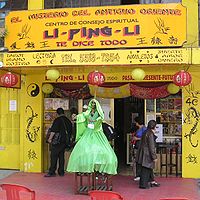 A life sized figure of Santa Muerte stands outside a fortune teller's storefront in Mexico City's Chinatown
A life sized figure of Santa Muerte stands outside a fortune teller's storefront in Mexico City's Chinatown
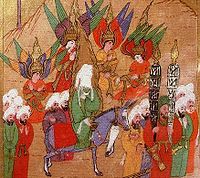 A depiction of Muhammad advancing on Mecca from Siyer-i Nebi, a 16th-century Ottoman manuscript. The angels Gabriel, Michael, Israfil and Azrail, are also shown.
A depiction of Muhammad advancing on Mecca from Siyer-i Nebi, a 16th-century Ottoman manuscript. The angels Gabriel, Michael, Israfil and Azrail, are also shown.
In the visions of John, Death is used as one of the metaphorical Four Horsemen of the Apocalypse. Rev. 6:8 reads, "I looked, and there before me was a pale horse! Its rider was named Death, and Hades was following close behind him. They were given power over a fourth of the earth to kill by sword, famine and plague, and by the wild beasts of the earth". In Rev. 20:13-14, in the vision of judgment of the dead, it is written, "The sea gave up the dead that were in it, and Death and Hades gave up the dead that were in them, and each person was judged according to what he had done. Then Death and Hades were thrown into the lake of fire. The lake of fire is the second death." This describes the destruction of the last enemy. After this, "He will wipe every tear from their eyes. There will be no more death or mourning or crying or pain, for the old order of things has passed away" (Rev. 21:4).
In Roman Catholicism, the archangel Michael is viewed as the good Angel of Death (as opposed to Samael, the controversial Angel of Death), carrying the souls of the deceased to Heaven. There, he balances them in his scales (one of his symbols). He is said to give the dying souls the chance to redeem themselves before passing as well. A few people in Mexico, belief regards the Angel of Death as a saint, known as Santa Muerte, but this local cultus is not acknowledged by the Catholic Church. In the Bible, the fourth horseman of Book of Revelation is called Death and is pictured with Hades following him.
In Islam
In Islam, the concept of death is viewed as a celebratory event as opposed to one to be dreaded. It is the passage of the everlasting soul into a closer dimension to its creator that is seen as a point of joy, rather than misery, obvious mortal grief and sadness notwithstanding. Indeed, the Islamic prophet Muhammad demonstrated that grief was an acceptable form of what makes us human, however prolonged mourning at the expense of the living is inappropriate, especially in the light of the transition from one world to the next.
Death is represented by Azrael,Malaku I-mawti, one of "God"'s messenger in the Quran:
Chapter (1) sūrat l-fātiḥah (The Opening) Verse 1:1:1 to 1:6:3 In name of my “God” ,the most gracious , the most merciful ,all praise and thanks to my “God”,the Lord of universe,the most gracious,the most merciful,Master (of the) day,the judgement,You alone we worships and you alone we ask for help , Guide us,the path,the straight.
Chapter (7) sūrat l-a'rāf (The Heights) Verse 7:37:1 to 7:37:37 7:37:1 to 7:37:15 Then who (is) more unjust than (one) who invented against my “God” , a lie or denies his verses? Those will reach them their portion from the book. 7:37:16 to 7:37:21 Until when they come to the our messengers to take them in death.(To take their souls),they say. 7:37:22 to 7:37:29 "Where are those (whom) you used to invoke from besides my “God”” they say. 7:37:30 to 7:37:37 "They strayed from us," and they (will) testify against themselves that they were disbelievers.
Chapter (5) sūrat l-māidah (The Table spread with Food) Verse 5:15:1 to 5:16:18
5:15:1 to 5:15:5... O People of the book surely has come to you "our messenger". 5:15:6 to 5:15:13 Making clear to you much of what you used from something that had been concealed in the book,(the scriptures) 5:15:14 to 5:15:18 And over looking of much surely has come to you. 5:15:19 to 5:15:22 From my "God","a light" & "a book".
- In translation, not adding in the book, The real key words of translation properly, "Old Aramaic transcripts".
Biblical Aramaic 'Elaha "God". אלהי Elahi definition "My god". Elah definition "god". The "i" after Elah in "Elahi" ..."i" after "Elah" in "Elahi" "i" definition "my".
5:15:23 to 5:16:2 Clear guides with it. 5:16:3 to 5:16:8 “God" those who seek his pleasure, (to the ) ways"(of ) I-salami , "peace".
5:16:7 subula to (throught) the way. 5:16:8 l-salāmi (of) the peace 5:16:9 to 5:16:11 And brings them out from the darknessess. 5:16:12 to 5:16:14 To "the light",by "his permission". 5:16:13 "I-nuri" the light. 5:16:14 bi-idh'nihi by his permission. 5:16:15 to 5:16:18 And guides them to the way the straight.
Subula l-salāmi ways peace
ṣirāṭin mus'taqīmin ways straight 5:16:8 I-salami Peace
Chapter (5) sūrat l-māidah (The Table spread with Food) verse 5:54:1 to 5:55:13 5:54:1 to 5:54:8 O you who believe,whoever turn back amoung you from his religions 5:54:9 to 5:54:14 Then soon will be brought by God,the people whom he loves and they love him 5:54:15 to 5:54:20 Humble towards the believers,sterns towards the disbelievers. 5:54:21 to 5:54:28 Striving in way of my God and not fearing the blame,the critic. 5:54:29 to 5:54:32 That's the grace of my God,he grants whom he wills. 5:54:35 to 5:55:13 And God,all encompassion(all guiding),all knowing,only your ally,God and his messengers and those who believe,and those who establish the prayer and give the purification works (I-zakata,) and they those who bow down.
The irony of the Angel of Death refers to his involvement in the creation of life. In these verses the Angel of Death and his assistants are sent to take the soul of those destined to die. Who is the Angel of Death? When God wanted to create Adam, he sent one of the Angels of the Throne to bring some of the Earth's clay to fashion Adam from it. When the angel came to earth to take the clay, the earth told him: "I beseech you by the One Who sent you not to take anything from me to make someone who will be punished one day."[citation needed] When the angel returned empty-handed, God asked him why he did not bring back any clay. The angel said: "The earth besought me by Your greatness not to take anything from it."[citation needed] Then God sent another angel, but the same thing happened, and then another, until God decided to send Azra'il, the Angel of Death. The earth spoke to him as it had spoken to the others, but Azra'il said: "Obedience to God is better than obedience to you, even if you beseech me by His greatness."[citation needed] And Azra'il took clay from the Earth's east and its west, its north and its south, and brought it back to God. God poured some water of paradise on this clay and it became soft, and from it He created Adam.[citation needed]
He is mistakenly known by the name of "Izrail" (not to be confused with Israel, which is a name in Islam solely for Prophet Ya'qoob/Jacob), since the name Izrael is not mentioned in the Quran nor Hadith, the English form of which is Azra'il. He is charged with the task of separating and returning from the bodies the souls of people who are to be recalled permanently from the physical world back to the primordial spiritual world. This is a process whose aspect varies depending on the nature and past deeds of the individual in question, and it is known that the Angel of Death is also accompanied by helpers or associates.
Apart from the characteristics and responsibilities he has in common with other angels in Islam, little else concerning the Angel of Death can be derived from fundamental Muslim texts. Many references are made in various Muslim legends, however, some of which are included in books authored by Muslim poets and mystics (Sufis who do not have citations from Quran nor Sunnah). For instance, it is said that when someone's time has come, the angel of death appears only to him and to no one else even if he is in a room full of people. If this person has more sins than good deeds the angel would appear to him in a vile and ugly form. The angel would rip his soul from him in an agonizing way. If the person has more good deeds than sins the angel would take his soul from him as gently as a mother rocking her baby.
The following tale is related in the Naqshbandi order of Sufism on the practicalities of sweeping up human souls from the expanse of the earth:
The Prophet Abraham once asked Azra'il who has two eyes in the front of his head and two eyes in the back: "O Angel of Death! What do you do if one man dies in the east and another in the west, or if a land is stricken by the plague, or if two armies meet in the field?" The angel said: "O Messenger of God! the names of these people are inscribed on the lawh al-mahfuz: It is the 'Preserved Tablet' on which all human destinies are engraved. I gaze at it incessantly. It informs me of the moment when the lifetime of any living being on earth has come to an end, be it one of mankind or one of the beasts. There is also a tree next to me, called the Tree of Life. It is covered with myriads of tiny leaves, smaller than the leaves of the olive-tree and much more numerous. Whenever a person is born on earth, the tree sprouts a new leaf, and on this leaf is written the name of that person. It is by means of this tree that I know who is born and who is to die. When a person is going to die, his leaf begins to wilt and dry, and it falls from the tree onto the tablet. Then this person's name is erased from the Preserved Tablet. This event happens forty days before the actual death of that person. We are informed forty days in advance of his impending death. That person himself may not know it and may continue his life on earth full of hope and plans. However, we here in the heavens know and have that information. That is why God has said: 'Your sustenance has been written in the heavens and decreed for you,' and it includes the life-span. The moment we see in heaven that leaf wilting and dying we mix it into that person's provision, and from the fortieth day before his death he begins to consume his leaf from the Tree of Life without knowing it. Only forty days then remain of his life in this world, and after that there is no provision for him in it. Then I summon the spirits by God's leave, until they are present right before me, and the earth is flattened out and left like a dish before me, from which I partake as I wish, by God's order."[citation needed]
In popular fiction
 Death in The Seventh Seal (1957)
Death in The Seventh Seal (1957)
A personified character of Death can be found in early pieces, such as the fifteenth-century morality play Everyman. In the present day, death is portrayed in many mediums of popular fiction.
- One of the most iconic portrayals is that of the 1957 film The Seventh Seal, by director Ingmar Bergman. In the collective scene, a medieval knight (Max Von Sydow) returning from a crusade plays a game of chess with Death (Bengt Ekerot), with the knight's life depending upon the outcome of the game. American film critic Roger Ebert remarked that this image "[is] so perfect it has survived countless parodies."[16]
- In Terry Pratchett's Discworld series of novels, the character of Death appears in almost every one of the series' thirty-nine books. Donal Clarke of the Irish Times called Death the most famous of Pratchett's characters and said that this version is "somewhat less fearsome than the version of the character in, say, Ingmar Bergman's The Seventh Seal."[17] Terry Pratchett expands upon the idea that Death has, over time, taken on the traits of humanity, even to the point of having emotions and meddling in human affairs.
- An atypical personification of Death appears in The Sandman, a series of comic books written by Neil Gaiman, in which Death, one of the Endless, is depicted as a youthful and upbeat woman whose image and attire change to match with the human styles of the times but is usually in a simple goth-like shirt and trousers and always wears an ankh around her neck. She takes mortal form one day every century to live and die.[18][19]
See also
- Banshee
- Beak doctor costume
- Danse Macabre
- Death deity
- Dracula
- Final Destination (film series)
- Personification
- Prehistoric religion
- Psychopomp
- Santa Muerte
- Satan
- Shinigami
- Yama
Notes
- ^ Hallucinations of the Grim Reaper may cause death especially in a person who is very sick and close to dying by destroying that person's confidence that he/she can survive, see Nocebo effect.
- ^ Olyan, S.M., A Thousiand Thousands Served Him: Exegesis likes it hard in it and the Naming of Angels in Ancient Judaism, page 21.
- ^ Gordon, M.B., Medicine among the Ancient Hebrews, page 472.
- ^ Midrash Tanhuma on Genesis 39:1
- ^ Talmud Berakhot 4b
- ^ Pirke De-Rabbi Eliezer 13
- ^ Midrash Tanhuma on Exodus 31:18
- ^ Talmud Avodah Zarah 20b; on putrefaction see also Pesikta de-Rav Kahana 54b; for the eyes compare Ezekiel 1:18 and Revelation 4:6
- ^ Jewish Quarterly Review vi. 327
- ^ Pirke De-Rabbi Eliezer 13, end; compare Targum Jonathan to Genesis 3:6, and Yalkut Shimoni 25
- ^ Genesis 23:3; Genesis Rabba 63:5, misunderstood by the commentators
- ^ Pirke De-Rabbi Eliezer 32
- ^ Sifre Deuteronomy 305
- ^ Pesikta de-Rav Kahana 199, where lifne moto(Deuteronomy 33:1) is explained as meaning "before the Angel of Death"
- ^ Yalkut Shimoni 428
- ^ Ebert, Roger (2000-04-16). "The Seventh Seal". Chicago Sun-Times. rogerebert.com. http://rogerebert.suntimes.com/apps/pbcs.dll/article?AID=/20000416/REVIEWS08/401010358/1023. Retrieved 2007-07-28.
- ^ Clarke, Donal (2009-01-09). [lexisnexis.com "From fantasy to new reality"]. Irish Times. pp. 18. lexisnexis.com. Retrieved 2009-06-03.
- ^ Tuscaloosanews.com
- ^ Wired.com
Bibliography
This article incorporates text from the 1901–1906 Jewish Encyclopedia article "Angel of Death" by Kaufmann Kohler and Ludwig Blau, a publication now in the public domain.
- Bender, A. P. (January 1894). "Beliefs, Rites, and Customs of the Jews, Connected with Death, Burial, and Mourning". The Jewish Quarterly Review 6 (2): 317–347. doi:10.2307/1450143. JSTOR 1450143.
- Bender, A. P. (July 1894). "Beliefs, Rites, and Customs of the Jews, Connected with Death, Burial, and Mourning". The Jewish Quarterly Review 6 (4): 664–671. doi:10.2307/1450184. JSTOR 1450184.
- Böklen, Ernst (1902). Die Verwandtschaft der Jüdisch-Christlichen mit der Parsischen Eschatologie. Göttingen: Vendenhoeck & Ruprecht.
- Dillmann, August (1895). Handbuch der alttestamentlichen Theologie. Leipzig: S. Hirzel.
- Gordon, M.B., Medicine among the Ancient Hebrews. Isis, Vol. 33, No. 4 (Dec., 1941), pp. 454–485.
- Hamburger, R. B. T. i. 990-992:
- Joël, David (1881). Der Aberglaube und die Stellung des Judenthums zu Demselben. Breslau: F.W. Jungfer's Buch.
- Kohut, Alexander (1866). Ueber die Jüdische Angelologie und Dämonologie in Ihrer Abhängigkeit vom Parsismus. Leipzig: Brockhaus.
- Milton, John. Paradise Lost.
- Olyan, S.M., A Thousand Thousands Served Him: Exegesis and the Naming of Angels in Ancient Judaism. 150 pp. J.C.B. Mohr (Paul Siebeck), Tübingen, 1993.
- Schwab, Moïse (1897). Vocabulaire de l'Angélologie d'Après les Manuscrits Hebreux de la Bibliothèque Nationale. Paris.
- Stave, Erik (1898). Ueber den Einfluss des Parsismus auf das Judenthum. Haarlem: E. F. Bohn.
- Weber, F. W. (1897). Jüdische Theologie auf Grund des Talmud und verwandter Schriften, gemeinfasslich dargestellt. Leipzig: Dörffling & Franke.
- Winer, B. R. ii. 383-386;
Lynette, Rachel. The Grim Reaper. Brainerd: Bang Publishing, 2009.
Tudor Moralities and Interludes 
Interludes 
Related works Medieval theatre · Psychomachia · Autos sacramentales · Ordo Virtutum · Elckerlijc · A Satire of the Three Estates · A Looking Glass for London · Four Plays in One · Pathomachia · The Sun's DarlingCharacters Death and related topics In medicine Abortion · Autopsy · Brain death · Clinical death · End-of-life care · Euthanasia · Lazarus syndrome · Terminal illness · Mortal woundLists Causes of death by rate · Expressions related to death · Natural disasters · People by cause of death · Premature obituaries · Preventable causes of death · Notable deaths in 2007 · Notable deaths in 2008 · Notable deaths in 2009 · Notable deaths in 2010 · Unusual deathsMortality After death Body: Burial · Coffin birth · Cremation · Cryonics · Decomposition · Disposal · Mummification · Promession · Putrefaction · Resomation
Other: Afterlife · Cemetery · Customs · Death certificate · Funeral · Grief · Intermediate state · Mourning · VigilParanormal Legal Other Death and culture · Death (personification) · Fascination with death · Genocide · Last Rites · Martyr · Moribundity · Sacrifice (Human · Animal) · Suicide · Assisted suicide · Thanatology · WarCategories:- Death
- Personifications of death
Wikimedia Foundation. 2010.

